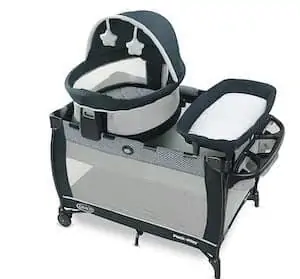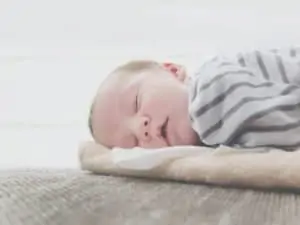You brought your sweet new baby home, but no matter what you do, your baby won’t sleep in the bassinet. This is something that almost all parents have faced in their lives; you aren’t alone.
While it’s frustrating for us because we want to take a nap as well, take comfort in knowing that your baby just wants to be close to you. She spent the last 40 weeks in your womb, listening to your heartbeat, feeling warm and cozy, and being in her comfort zone all the time.
Now, her world is different, and being separate from you feels scary. When you became a new mom, you knew that your baby wouldn’t sleep much, but you might not have realized your baby won’t want to sleep apart from you.
With the right tips and tricks, you can get your baby to sleep in the bassinet. You just have to learn what works for your baby.
Why Do Babies Dislike Sleeping in the Bassinet?
Before you can fix the problem, you have to understand why you have a problem at all. It seems strange that a baby can dislike a bassinet SO MUCH, but they act as if you laid them down on a bed of nails.
My babies fought the bassinet or any sleeping surface that wasn’t with me like it was a torture chamber.
What is wrong with them?
It’s quite reasonable for babies to dislike a bassinet, and here are some of the common reasons why your child might put up a fight.
They’re Apart From You
As I mentioned before, your baby spent his unborn life with you, so being apart from you feels uncomfortable and weird. All he wants to do is sleep on your chest or snuggle in your arms.
While it IS safe for your baby to sleep on your chest while you’re awake (perfect time to do skin to skin!), it’s not safe for you to go to sleep with your baby on your chest. So, since we are all human and need to sleep, you do need your baby to lay down and go to sleep in his bassinet.
It’s New and Unknown
Anything new can be scary for babies; babies like routine and the known. It makes them feel secure. They aren’t used to going to sleep in the bassinet.
The Moro Reflex
Never heard of the Moro Reflex? It’s sometimes called the startle reflex, and it’s what causes your baby to throw out his arms when you lay him down to sleep in the bassinet.
Nothing is more frustrating than trying to lay down your baby, who is sound asleep in his bed only for him to throw out his arms and wake up. Then, he’s up – no baby goes back to sleep after being startled awake!
Stomach Discomfort
Babies are prone to stomach discomfort. It might be from colic or acid reflux. Either way, if your baby has stomach pain, then chances are your baby won’t sleep in the bassinet.
This can be due to lying down flat. Some babies do struggle to lay down flat on their backs because it causes the reflux to come up and burns the back of their throat. If you’ve ever had heartburn or acid reflux, you understand the feeling and discomfort.
It’s Uncomfortable and Open
The womb is warm and cozy, so you can imagine that an open bassinet wouldn’t feel the same. It’s not safe to have blankets or pillows in a bassinet or any sleeping surface for your child, but you do need to make sure they have a sense of being cozy.
Pick the Right Baby Bassinet
Let’s quickly take a look at the different types of bassinets to make sure you pick the best one for your baby. 😀
Co-Sleeper Bassinet
This is the type of bassinet that I used with my four kids. It’s a bassinet that lets your baby sleep as close to you as possible without bringing your baby into bed with you.
Typically, this style of bassinet has a strap that attaches underneath your mattress. Many can convert into a freestanding bassinet because the side that connects to the side of your bed folds up. So, you don’t have to connect it to your bed unless you want to do so.
Bassinet with Movement
Consider buying a bassinet with movement. Some can be more expensive than others, but you can find some that react and start to move when your baby cries. That can buy you extra sleep time. Some operate on batteries and have a simple swaying motion that rocks your baby back to sleep.
If you find that your baby loves the swing and wants to sleep in it (which isn’t safe), consider finding a bassinet that has movement.
Freestanding Bassinet
As you might imagine, a freestanding bassinet is one that stands on its own feet. It can be placed beside your bed or wherever it needs to go, but they do need to be bulkier and take up a lot of space. This style has high sidewalls, so you do need to get out of bed to get your baby. Some have wheels so you can move the bassinet around as you need.
Multipurpose Bassinet
This type of bassinet serves multiple purposes. It might be a bassinet but then converts into a playpen later. These are practical choices, and the versatility makes it easier on the budget. Some of these bassinets even come with an attached changing station.
How Long Can My Baby Sleep in a Bassinet?
How long you can use a bassinet depends on the type of bassinet that you select. Be sure to read the recommendation before you make your final purchase.
Some bassinets, typically the freestanding ones, state that you need to stop using it when your baby can rollover. These are small spaces, so if your baby rolls over, he can become pinned against the side. That’s why it’s vital to use a bassinet with mesh sides.
Other bassinets, such as the co-sleeping bedside ones, can be used until your child can sit up independently. That could be around six months old. Be sure to read all about the bassinet before buying it!
5 Tips to Help Your Baby Sleep in the Bassinet
Here are some tips to help you get your baby to sleep in his bassinet.
Sleep on the Bassinet Sheets
Remember that your baby doesn’t want to be away from you, but you might not know that babies have a strong sense of scent. Smells comfort your child; their vision is still improving in the early weeks and months of their lives.
Try sleeping on the bassinet sheets for a few days or keep the sheets in your shirt. Don’t worry if a few drops of breast milk end up on the sheets; that will be even more reassuring. Doing this transfers your scent to the sheets and helps your child feel more comfortable while you’re away from him.
Bedtime Routine
Bedtime routines are crucial for your baby to help him know that it’s time to go to sleep. Routines don’t need to be complicated; the goal is to help your baby’s body recognize that it’s time to go to sleep soon.
Make sure you keep the lights down lower as well as the noise level. It can be a good idea to turn off electronics because blue light can mess with your baby’s sleep cycle.
I recommend that you keep a simple routine you can do each night. That’s why I don’t include bathtime in my routines because my babies don’t take a bath daily. Dry skin is a perpetual issue for my little ones, so instead, here is our regular nighttime routine for our infants.
- Turn off the TV and dim the lights throughout the house
- Put on pajamas
- Lotion their skin and do a quick baby massage
- Read a book – Yes, start at birth!
- Nurse (or give a bottle)
- Rock to sleep or lay your baby down awake, whichever you prefer.
Swaddle Your Baby
Remember that frustrating startle reflex? One way you can reduce that is by swaddling your baby. Swaddling mimics the coziness and warmth of the womb. Many babies love it and sleep soundly when swaddled.
Something important to note is that you don’t want to swaddle after your baby can roll over. At that point, it’s no longer safe, and that can happen between 8-12 weeks. Watch for signs that your baby is rolling over now or about to start doing so.
Here is how to use baby bassinet with safety.
Wait Until Your Baby is Sound Asleep
Some parents lay their babies down awake in their bed, and that’s fine if it’s what you want to do. That’s something that I always decided not to do because I let my child fall asleep while breastfeeding.
This is important:
One mistake that you don’t want to make is trying to lay your baby down right after he falls asleep. At that point, he’s in very light sleep, and any movement or change of position can wake up your baby.
Instead, start paying attention to your baby’s change of breathing and the relaxation of his body. Babies tend to slow their breath, and you might notice that their eyes are moving under their lids. Typically, waiting 10 minutes before putting your baby down to sleep can yield excellent results.
Be Persistent
It’s hard; I feel you there, but being persistent is an essential part of parenting in general. Babies do adapt if you continue to lay him down time after time. It might not be what your baby wants to do, which is sleep on you at all times. However, over time, he’ll get used to you laying him down in the bassinet.
Final Thoughts
Every parent has walked in your shoes. I know I’ve cried to my friends that my baby won’t sleep in the bassinet, and they cried with me because they went through it as well.
Remember that this too shall pass, and after some time, your baby will get used to sleeping in their bassinet or even their crib. Be persistent and try swaddling to get the best sleep for both of you.
Hey, this is Linda. My biggest accomplishment in life is being a mother of four children. Their current ages range from almost ten years old down to 20 months old.
I’m passionate about writing parenting articles because I understand so well all of the problems and trials you face as a parent. From breastfeeding woes to budgeting problems and behavior problems, along with everything in between, chances are I’ve faced it over the last ten years. Read more about Linda here.







